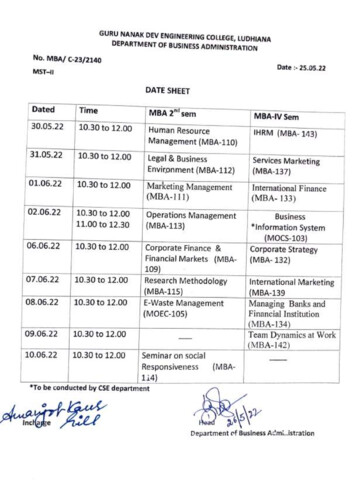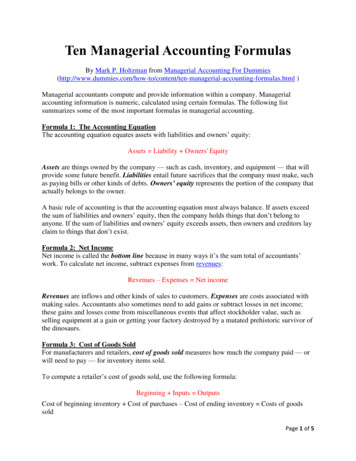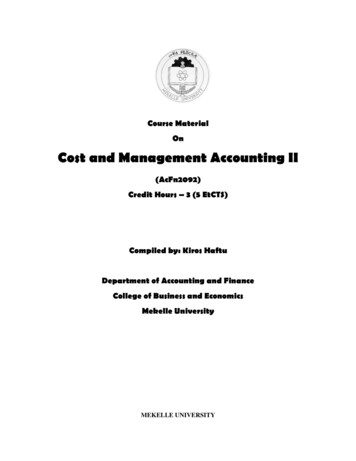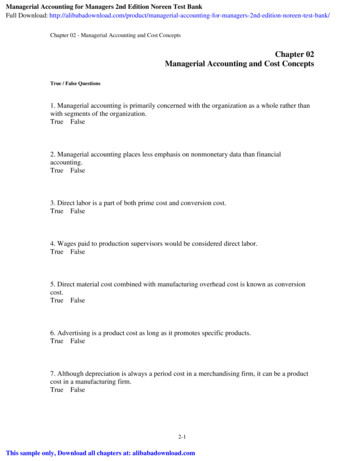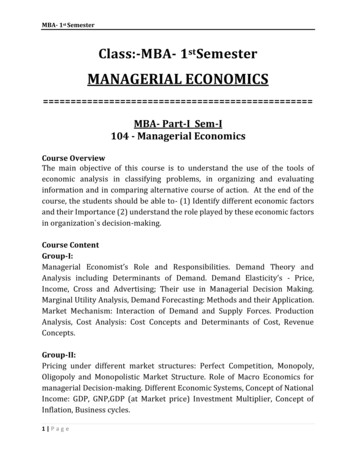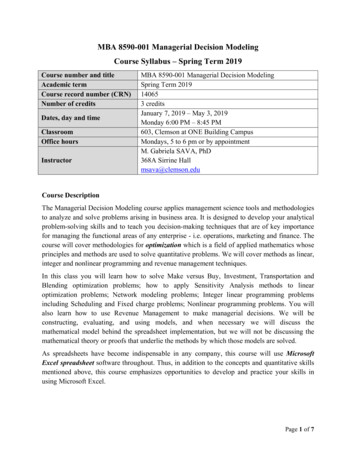
Transcription
MBA 8590-001 Managerial Decision ModelingCourse Syllabus – Spring Term 2019Course number and titleAcademic termCourse record number (CRN)Number of creditsDates, day and timeClassroomOffice hoursInstructorMBA 8590-001 Managerial Decision ModelingSpring Term 2019140653 creditsJanuary 7, 2019 – May 3, 2019Monday 6:00 PM – 8:45 PM603, Clemson at ONE Building CampusMondays, 5 to 6 pm or by appointmentM. Gabriela SAVA, PhD368A Sirrine Hallmsava@clemson.eduCourse DescriptionThe Managerial Decision Modeling course applies management science tools and methodologiesto analyze and solve problems arising in business area. It is designed to develop your analyticalproblem-solving skills and to teach you decision-making techniques that are of key importancefor managing the functional areas of any enterprise - i.e. operations, marketing and finance. Thecourse will cover methodologies for optimization which is a field of applied mathematics whoseprinciples and methods are used to solve quantitative problems. We will cover methods as linear,integer and nonlinear programming and revenue management techniques.In this class you will learn how to solve Make versus Buy, Investment, Transportation andBlending optimization problems; how to apply Sensitivity Analysis methods to linearoptimization problems; Network modeling problems; Integer linear programming problemsincluding Scheduling and Fixed charge problems; Nonlinear programming problems. You willalso learn how to use Revenue Management to make managerial decisions. We will beconstructing, evaluating, and using models, and when necessary we will discuss themathematical model behind the spreadsheet implementation, but we will not be discussing themathematical theory or proofs that underlie the methods by which those models are solved.As spreadsheets have become indispensable in any company, this course will use MicrosoftExcel spreadsheet software throughout. Thus, in addition to the concepts and quantitative skillsmentioned above, this course emphasizes opportunities to develop and practice your skills inusing Microsoft Excel.Page 1 of 7
Learning GoalsBy the end of this course, students should be able to:-Think critically and analytically about business problems encountered in real life.Be able to model the real-life situations using the mathematical tools presented during theclass.Gather and evaluate the information available in the real life situations effectively andappropriately.Understand and be able to apply basic quantitative reasoning and methodologies to realbusiness problems.Use spreadsheets to analyze problems from different business areas.Students will also improve their competency in Business Analysis and Decision Making appliedto fields like operations, finance, marketing and other areas.Course TextbookThe course requires the following textbook: Cliff T. Ragsdale, Spreadsheet Modeling and Decision Analysis. A Practical Introductionto Business Analytics, 8th edition, Cengage LearningYou are welcome to use a hardcopy or an electronic version, if you prefer.Course SoftwareWe will be using primarily Microsoft Excel and the software available with the textbook whichincludes the Analytic Solver Platform for optimization. To get the software proceed as instructedin “Instructions to install the Analytic Solver Platform.docx.” The course code and thetextbook code are provided in the file. The SolverSetup.exe Setup program may prompt for apassword and license activation code, which will be emailed to you.Make sure that the Solver Add-in is installed in your laptop before coming to class.CanvasWe will be using Canvas (https://clemson.instructure.com/login/canvas), the Clemson Universitycourse management system. I will post here all the material necessary for this class and theassignments. You will find there the following items: Syllabus - updated as needed throughout the term. Course schedule - with week-by-week readings and problem assignments dates (subjectto updates during the semester). Course handouts – lecture slides, problems templates, assignments solutions, classrecordings, group project details.Page 2 of 7
Course assignments and Group Project - are to be submitted online using the linksprovided on Canvas.Course Method of Evaluation Course RequirementsRequirementPercentage of Final GradeAssignments (equally weighted)20%Group Project20%Midterm exam30%Final exam30%Total100%Note: All parts of the grade are mandatory.Final grades will be assigned as follows:A: 90-100%; B: 80-89%; C: 70-79%; F: 69% AssignmentsAssignments need to be organized and complete to be acceptable. I expect you to clearly labelyour work and present all the steps you followed to obtain the final results.Here’s a checklist that you can follow when completing your assignment for both the pen andpaper and Excel problems:-Each problem should be identified by the chapter number, the problem number and thetextbook page;Provide complete explanations for the problems requiring solution interpretation;All the problems assigned should be saved in ONE Excel file with multiple tabsidentifying each problem;Excel file should be saved with your name and the assignment number (e.g.GabrielaSava HW1.xlsx);The assignments are shown in the course schedule and there are due on Monday at 6 pm. Iexpect you to complete the assignments on time. Late assignments will not be accepted. Pleasesubmit the online assignments using the Assignment tool feature in Canvas page for this class.You are permitted and encourage working and discussing the problems with your classmates,however you must submit your work independently. Group ProjectA case study is going to be assigned during this class, which can be solved in groups of up to fivestudents. You have to communicate to me by the end of the fifth class your groups or I willassign students randomly in groups. The deliverables for the group project will be your ExcelPage 3 of 7
files, a brief report and a presentation during the last day of class. The case study solution isgoing to be submitted online and its due as it is shown in course schedule. The case study willcount for 20% of your final grade. Midterm and Final examOpen book/notes midterm and final exams will be given in class as identified in the courseschedule. You should bring your own laptop for the exams. During the exams there will be nocommunication with fellow students and the web browsing is forbidden. Make sure that youdownloaded all the necessary materials before coming to exam. Both the midterm and final examwill count each for 30% of your final grade.All students are expected to take the examination on the scheduled day. In general, there will beno make-up exams. However, in the event of final exam is missed to either a pre-approvedabsence by the instructor or due to an illness documented by a physician’s note, arrangementsmay be made to make-up the exam. Make-up examinations are at the discretion of the instructor.Attendance policyStudents who must miss class are responsible for all material covered and all announcementsmade in their absence. In the unlikely event that the professor may miss a class, students mayleave after 15 minutes. In the event of snow, class will be held if the university is in sessionClassroom DecorumPlease come to the class on time, and do not leave during the class unless it is absolutelynecessary. Please turn off your cell phones, pagers, etc. to not disturb the class unless you expecta medical emergency, in which case please take a seat near an exit. Please do not engage inconversations with your colleagues during class, or engage in other activities that may bedistracting to others nearby (for example, Facebook, e-mail, web surfing unrelated to the coursediscussion, etc.)Students may not record classroom lectures, discussion and/or activities without my advancewritten permission. Any such recording, properly approved in advance, can be used solely for thestudent’s own private use.Students with DisabilitiesAppropriate accommodations will be made for students with disabilities that are documented byDisabilities Services. Students must present a letter stating that the disability has beendocumented and requesting the specific accommodations early in the semester. Additionally, it isthe responsibility of the student to give the professor at least one-week notice prior to eachinstance where an accommodation will be needed.The Clemson University Title IX (Sexual Harassment) Statement:Clemson University is committed to a policy of equal opportunity for all persons and does notdiscriminate on the basis of race, color, religion, sex, sexual orientation, gender, pregnancy,Page 4 of 7
national origin, age, disability, veteran’s status, genetic information or protected activity (e.g.,opposition to prohibited discrimination or participation in any complaint process, etc.) inemployment, educational programs and activities, admissions and financial aid. This includes aprohibition against sexual harassment and sexual violence as mandated by Title IX of theEducation Amendments of 1972. The policy is located s/access/non-discrimination-policy.htmlJerry Knighton serves as Clemson’s Title IX Coordinator and he may be reached atknightl@clemson.edu or 656-3181.Academic Integrity:"As members of the Clemson University community, we have inherited Thomas GreenClemson's vision of this institution as a "high seminary of learning." Fundamental to this visionis a mutual commitment to truthfulness, honor and responsibility, without which we cannot earnthe trust and respect of others. Furthermore, we recognize that academic dishonesty detracts fromthe value of a Clemson degree. Therefore, we shall not tolerate lying, cheating, or stealing in anyform. In instances where academic standards may have been compromised, Clemson Universityhas a responsibility to respond appropriately to charges of violations of academic integrity."Page 5 of 7
Course ScheduleDayLecture 1January 7Lecture 2January 14January 15LectureJanuary 21January 23Lecture 3January 28Lecture 4February 4Lecture 5February 11Lecture 6February 18Lecture 7February 25Lecture topicIntroductionReadingsAssignments Due on MONDAYs at 6 pmChapter 1Introduction to Optimization and LinearChapter 2ProgrammingLast day to register or add a class or declare AuditHW 1Due January 28No class – Martin Luther King Jr.Last day to drop a class or withdraw from the University without a W gradeModeling and Solving LP Problems Production ProblemChapter 3 HW 23.0 to 3.10Due February 4 Make vs Buy Problem Investment ProblemModeling and Solving LP Problems Transportation ProblemChapter 3 –HW 3 Blending Problem3.11 to 3.13Due February 11 Production and InventoryPlanning ProblemModeling and Solving LP Problems –HW 4Case studyDue February 18Chapters 3, 4Sensitivity Analysis for LP ProblemsNetwork Modeling Transshipment Problem Shortest Path Problem Assignment ProblemNetwork Modeling Generalized Network FlowProblem Maximal Flow ProblemGroups for the Group Project are dueChapter 5 –5.0, 5.1, 5.2, 5.4HW 5Due February 25Chapter 5 –5.5, 5.6HW 6Due March 4Page 6 of 7
Lecture 8March 4LectureMarch 11March 15LectureMarch 18Lecture 9March 25Lecture 10April 1Lecture 11April 8Lecture 12April 15Network Modeling – Case studiesChapter 5Midterm revisionMidterm ExamLast day to drop a class or withdraw from the University without final gradesNo class – Spring BreakInteger Linear Programming Employee Scheduling Problem Capital Budgeting ProblemInteger Linear Programming Fixed Charge ProblemCase studyNonlinear Programming Production Problem Economic Order Quantity Model Location Problem Portfolio Selection ProblemRevenue ManagementNonlinear Programming – case studyChapter 6 –6.0 to 6.13HW 7Due April 1Chapter 6 –6.14, 6.17HW 8Due April 8Chapter 8 –8.0 to 8.5, 8.9HW 9Due April 15Group Project is assignedDue April 22Final exam revisionLecture 13April 22LectureApril 29In-class Group Project presentationsFinal ExamPage 7 of 7
MBA 8590-001 Managerial Decision Modeling Course Syllabus - Spring Term 2019 Course number and title MBA 8590-001 Managerial Decision Modeling Academic term Spring Term 2019 Course record number (CRN) 14065 Number of credits 3 credits Dates, day and time January 7, 2019 - May 3, 2019 Monday 6:00 PM - 8:45 PM

